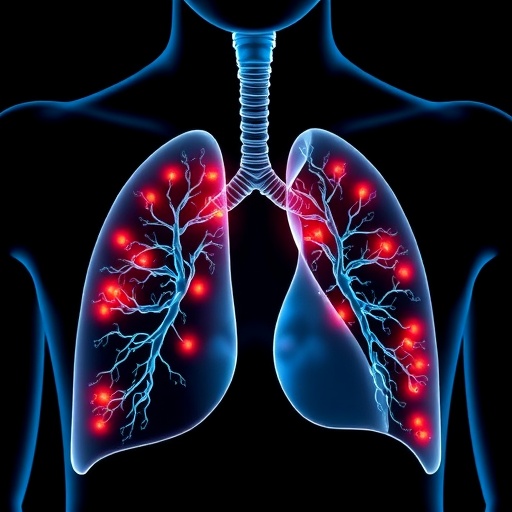In a groundbreaking advancement in the treatment of advanced non-small cell lung cancer (NSCLC) harboring epidermal growth factor receptor (EGFR) mutations, new data from the phase 3 global FLAURA2 trial have demonstrated a significant improvement in overall survival when osimertinib is combined with platinum–pemetrexed chemotherapy, compared with osimertinib monotherapy. This pivotal study, co-led by science and clinical experts at the Dana-Farber Cancer Institute and Gustave Roussy in France, opens a new chapter for first-line treatment strategies against this aggressive form of lung cancer that predominantly affects non-smokers and patients of Asian descent.
The FLAURA2 trial enrolled patients diagnosed with EGFR-mutated advanced NSCLC to evaluate the efficacy of combining the third-generation EGFR tyrosine kinase inhibitor (EGFR-TKI) osimertinib with chemotherapy upfront, contrasting these results against those with osimertinib alone. The rationale behind this approach stems from the known limitations of monotherapy where patients frequently experience disease recurrence despite initial tumor response. Adding platinum-based chemotherapy from the onset aims to delay or prevent the development of resistance mechanisms that typically undermine long-term treatment efficacy.
Statistically robust, the final overall survival data reveals a median survival of 47.5 months for patients treated with the combination therapy versus 37.6 months for those on osimertinib alone, indicating nearly a 10-month survival advantage. This unequivocal difference not only confirms the clinical benefit but also represents the longest overall survival reported to date in this patient population, highlighting the potential of combination therapy to redefine standards of care in EGFR-mutant NSCLC.
Importantly, subgroup analyses illustrate pronounced benefits in patients with notoriously poor prognoses. Those battling central nervous system metastases—commonly associated with dismal outcomes—experienced a median overall survival of 40.9 months under combination treatment, compared to just 29.7 months with monotherapy. This finding showcases the therapy’s efficacy in crossing the blood-brain barrier or controlling systemic disease progression more effectively, an essential consideration given the frequency of brain metastases in EGFR-mutant NSCLC.
At a molecular level, EGFR mutations drive aberrant signaling pathways that propel uncontrolled cell proliferation and tumor growth. Osimertinib, designed as a third-generation selective EGFR-TKI, irreversibly binds mutant EGFR and inhibits downstream signaling, thereby suppressing tumor cell survival. However, resistance invariably emerges, stemming from multiple mechanisms such as secondary mutations or alternative signaling activation. Integrating platinum-based chemotherapy—pemetrexed plus a platinum agent—augments cytotoxic effects, destroying cancer cells through DNA crosslinking and antimetabolite activity, which provides a multi-pronged attack on tumor viability.
These promising results found regulation and clinical endorsement following the U.S. Food and Drug Administration’s accelerated approval of the combination therapy in February 2024, primarily based on progression-free survival benefits. The latest publication in the New England Journal of Medicine and presentation at ESMO Congress 2025 validate overall survival improvements, an endpoint considered the gold standard in oncology trials, ensuring this regimen’s rightful place in therapeutic algorithms.
Side effect profiles associated with the combination therapy reflect the added toxicity burden from chemotherapy. Patients commonly experience nausea, vomiting, fatigue, and bone marrow suppression manifesting early during the chemotherapy cycles. Nevertheless, these adverse events tend to diminish during maintenance phases, where osimertinib and pemetrexed sustain tumor control with a more tolerable side effect spectrum. This dynamic underscores the necessity for tailored supportive care and vigilant monitoring throughout treatment.
The FLAURA2 findings emphasize a paradigm shift from single-agent targeted therapy toward upfront combination regimens aimed at overcoming early therapeutic resistance and improving survival outcomes. Dr. Pasi A. Jänne, co-principal investigator and director of the Lowe Center for Thoracic Oncology at Dana-Farber, underscores that these findings mark a transformative development with potential to serve as a platform for future combinational strategies incorporating immunotherapies or novel agents, further extending patient benefit.
For clinicians and patients alike, the expanded therapeutic landscape presents both opportunities and challenges. Decision-making must balance maximizing efficacy with managing toxicity, highlighting the critical role of shared dialogues to personalize treatment plans. Patients with the option of combination therapy may prioritize extended survival despite increased side effects, whereas others might opt for monotherapy favoring quality of life. The key lies in informed consent and nuanced understanding of individual patient values and clinical circumstances.
Globally, EGFR mutations occur in approximately 10-15% of NSCLC patients in Western populations and up to 50% in Asia, marking a substantial targetable subgroup. With over half a million lung cancer deaths worldwide annually, effective treatments that significantly extend life are urgently needed. The FLAURA2 results thus resonate across geographies, offering a new standard of care to millions of patients worldwide suffering from this challenging malignancy.
Finally, these findings highlight the critical collaboration between academic cancer centers, industry, and regulatory agencies in accelerating therapeutic innovation. Funded by AstraZeneca, the study stands as a testament to the power of clinical research dedicated to transforming cancer from a fatal to a manageable disease, fortifying hope for future breakthroughs that bring us closer to curing lung cancer.
Subject of Research:
Article Title: Overall Survival with Osimertinib plus Chemotherapy in EGFR-Mutated Advanced NSCLC
News Publication Date: 17-Oct-2025
Web References: ESMO Congress 2025 presentation and New England Journal of Medicine publication
Image Credits: Dana-Farber Cancer Institute
Keywords: Lung cancer, Small cell lung cancer, EGFR inhibitors
Tags: advanced NSCLC first-line treatmentchemotherapy and targeted therapy combinationcombination chemotherapy for lung cancerDana-Farber Cancer Institute researchEGFR tyrosine kinase inhibitor efficacyEGFR-mutant non-small cell lung cancer treatmentFLAURA2 trial resultsnon-smokers lung cancer demographicsosimertinib and platinum-pemetrexedoverall survival in lung cancer patientsphase 3 clinical trials in oncologyresistance mechanisms in cancer therapy





